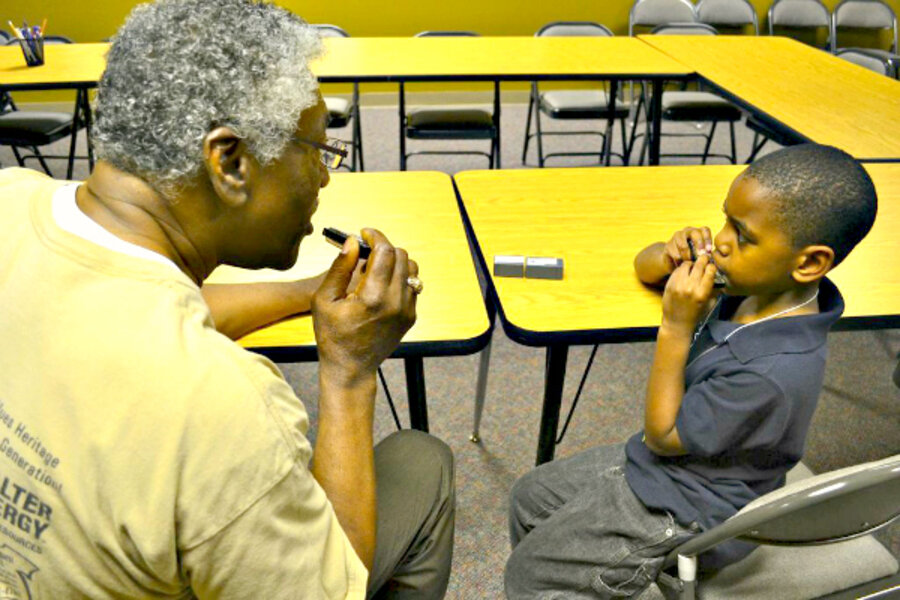Bringing home the blues, connecting kids to a proud heritage
Loading...
Rick Asherson plays a riff on his guitar. Blues musician Debbie Bond sings a line. She tells the classroom full of kids: Big Mama Thornton made that song a hit, and then Elvis Presley picked it up.
The pair launch into song. "You ain't nothin' but a hound dog," they sing.
Ms. Bond and Mr. Asherson are part of the Alabama Blues Project, taking blues music to schoolchildren who may not know that it’s part of their own history.
“We expose the next generation to the blues as an African-American art form that was invented in the South," Bond says.
The pair go into schools in the Black Belt counties of Alabama, where they say the children are being underserved.
“They don’t have music and art in these schools," she says. "They’re in some of the poorest areas of Alabama.”
They talk about the history of the music – it's the root of so much popular American music – and they teach how to play it.
Recently in a school in Camden, Ala., they pulled out a photo of a small cabin in Florence, Ala. This was the birthplace of W.C. Handy, known as the “Father of the Blues,” they tell the children.
"Blues is the root of rock and roll," they say. It started in Mississippi, Alabama, and other parts of the Deep South.
The Alabama Blues Project was co-founded by Bond in 1995 in Tuscaloosa, Ala. It is now a nonprofit group directed by Paula Demonbruen. This year, it began providing instruction in five Tuscaloosa after-school programs, in addition to its blues club for children and programs in other schools in Alabama.
In July Ms. Demonbruen led the annual summer Blues Camp in Tuscaloosa. Former camper Jonathan Blakney, 20, came back to help teach.
"It comes out of African music," he says of the blues. "Some of the African beats and rhythms survive."
Field hollers, spirituals, work songs, simple ballads, and shout and chants were among the 19th-century forms that evolved into the blues.
Mr. Blakney and Blues Project program director Cara Lynn Teague describe how early blues players made homemade instruments. Wires were hung on a wall to create a stringed instrument, a plow handle attached to a washtub and strung with rope became a washtub bass, and tobacco tins were used to create a harmonica-like instrument.
At the summer camp, the children learn about specific blues musicians. Lowell Jeff, 13, gives a report. "This is about Microwave Dave," he says. "His first gig was in a local church in Texas."
Crystal Bolden, 12, reports on Cow Cow Davenport, who was born in Anniston, Ala., and began playing vaudeville in the 1920s.
Mikayla Davis, 9, says "Big Mama Thornton was mainly a singer but taught herself to play harmonica and drums.
"The kids have a discussion led by a teacher’s aide and agree that Elvis should have given Thornton credit when he recorded "Hound Dog" in 1956, just a few years after she did.
Maizie Childers Siders, 11, reports on Odetta: "She was born in Birmingham. She sang 'Oh Freedom' on the steps of the Lincoln Memorial in 1963.
"Keante White, 14, picked musician Adolphus Bell.
"He grew up in Luverne, Ala., and worked as a farm laborer.
"Then the teacher projects a YouTube video on the wall. It’s Adolphus Bell, in flamboyant red costume and headgear, performing live in Paris.
As the music starts, the magic starts. This is what the kids have come for. They hear the wailing chords and the lazy drawn-out sound of "The Thrill is Gone," and they rock and sway and beat their feet on the floor.
For a moment, the world is not divided into adults and children, or black and white, or any other divisions, but simply people feeling the passion of this soul-stirring music.
Later, in the harmonica room, gruff musician Bruce Andrews, wearing a T-shirt and vest, sits facing a semi-circle of six little girls and two boys."Let's hear it, Claire," he says, and Claire blows in to the harmonica.
"Pucker up like you're kissing your grandma," he says. "That's it, baby," he says encouragingly.
They try a trill.
"Now let's put it with some rhythm," he says, and he begins: “Bo Diddley, Bo Diddley have you heard / Mama gonna buy you a mockingbird.
”In another room, eight children, each with a guitar, face musician SharBaby. She encourages them to strum and change chords. They all play as she sings "Hound Dog."
In the drum room, Dave Crenshaw instructs the children.
"Kick it harder. It's not going to break," he says to a child sitting at a drum set. Mr. Crenshaw begins playing his electric guitar, and the child pounds out a big noise with an irresistible rhythm. It sends a pulse throughout the room.
Music also slips out from under the doors where the intermediate and advanced students are playing.
"Our hope is that this will make them feel a sense of pride," says the director, Ms. Demonbruen. "It belongs to them." Maybe they'll come to feel that "this is something my great-great-grandparents contributed to society," she says.
The camp is a diverse group, a mixture of black and white kids across different income levels. But it reaches out to children disadvantaged by economic or family situations or just by the lack of arts education in their schools.
"The arts in general are powerful for teaching kids self-esteem," Bond says. The arts also help children learn a kind of critical-thinking process that schools have moved away from, she says. Blues music taps into emotion and life experience and provides a channel for expressing it.
And, as Mr. Andrews, the harmonica instructor, says: "There's a creative fire within people, and if you stoke it a little bit, it might just save their lives."







